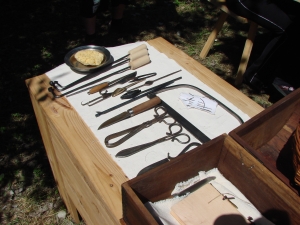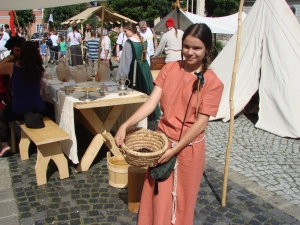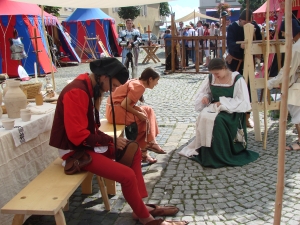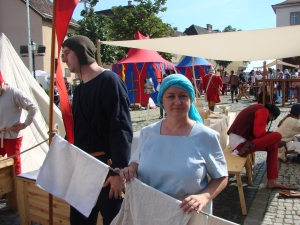
 |
  |
Introduction |
Lifestyle |
 |
 |  |  |  |
 |
Lifestyle reconstuction? Live interpretation?

 hat do the terms in the title mean? In the next few paragraphs we attempt to give an explanation and describe how we implement them in practice.
hat do the terms in the title mean? In the next few paragraphs we attempt to give an explanation and describe how we implement them in practice.
Lifestyle reconstruction:
 part of our school's effort is to study and present the everyday life of medieval people, disregarding whether it is about clothing, customs, beliefs, everyday work, handicraft, games or any other activity typical of the age. It is apparently a highly diversified and complicated task, since a withered and only scarcely extant world has to be recreated from the scratch. We are aware that it is nearly impossible, but we believe that without presenting the most authentic imagery of a bygone age possible (to our best knowledge) would be a misleadment and delusion of the attendees. Visualizing the correct image is however far more than simply putting on clothes (even if those are precise reconstructions), as for this an inanimous mannequin would likewise suit. Hence we trust that a character of the correspondent period can be presented properly only if the one impersonating her imbibes the customs, beliefs and lifestyle of the said era. This we call, provided it is based on scientific research and methods of archaeological experiments (and not on 'traditions'), lifestyle reconstruction. We find it necessary to clarify the term because according to our knowledge it was us who had been introduced it in Hungary, but since then others have also used it, with an interpretation somewhat different from ours.
part of our school's effort is to study and present the everyday life of medieval people, disregarding whether it is about clothing, customs, beliefs, everyday work, handicraft, games or any other activity typical of the age. It is apparently a highly diversified and complicated task, since a withered and only scarcely extant world has to be recreated from the scratch. We are aware that it is nearly impossible, but we believe that without presenting the most authentic imagery of a bygone age possible (to our best knowledge) would be a misleadment and delusion of the attendees. Visualizing the correct image is however far more than simply putting on clothes (even if those are precise reconstructions), as for this an inanimous mannequin would likewise suit. Hence we trust that a character of the correspondent period can be presented properly only if the one impersonating her imbibes the customs, beliefs and lifestyle of the said era. This we call, provided it is based on scientific research and methods of archaeological experiments (and not on 'traditions'), lifestyle reconstruction. We find it necessary to clarify the term because according to our knowledge it was us who had been introduced it in Hungary, but since then others have also used it, with an interpretation somewhat different from ours.

Live interpretation:
 e are not convinced that displaying the life of medieval people should solely be restricted to fighting duels (which often lack historical accuracy) on a stage. What percentage of the population dealt with fighting? What percent of the combats were duels? Should a contemporary show mean only this? Though we give special emphasis on the combat techniques of the Middle Ages but one reason for separating lifestyle reconstruction from martial arts reconstruction is that life in that era was much more than fighting. Moreover in contrast with stereotypes the overwhelming majority of the people did but rarely get involved in any combat situation.
e are not convinced that displaying the life of medieval people should solely be restricted to fighting duels (which often lack historical accuracy) on a stage. What percentage of the population dealt with fighting? What percent of the combats were duels? Should a contemporary show mean only this? Though we give special emphasis on the combat techniques of the Middle Ages but one reason for separating lifestyle reconstruction from martial arts reconstruction is that life in that era was much more than fighting. Moreover in contrast with stereotypes the overwhelming majority of the people did but rarely get involved in any combat situation.
 ive interpretation is also a term less known in Hungary. By singular first person interpretation we mean that the performer makes contact with the audience as if she had truly come from the past, or the attendees had travelled back to a bygone era. For authentic performance it is again vital that the performer be aware of the most possible small details and master-strokes of the profession of the person she impersonates, her reactions, actions and behaviour match to the historical age, country and social class she represents - at least to the one that historical studies currently find the most probable, even if it highly differs from public view.
ive interpretation is also a term less known in Hungary. By singular first person interpretation we mean that the performer makes contact with the audience as if she had truly come from the past, or the attendees had travelled back to a bygone era. For authentic performance it is again vital that the performer be aware of the most possible small details and master-strokes of the profession of the person she impersonates, her reactions, actions and behaviour match to the historical age, country and social class she represents - at least to the one that historical studies currently find the most probable, even if it highly differs from public view.
Research and tuition:
 ith consideration to the above we encourage our members to continue independent, but scientifically supported research, furthermore they attend and give lectures on various topics of lifestyle reconstruction, and they can sit for internal exams on some of these. To ensure the quality of research, tuition and performances we are members of the International Museum Theatre Alliance (I.M.T.A.L.) an association of the most significant museums and live interpreters.
ith consideration to the above we encourage our members to continue independent, but scientifically supported research, furthermore they attend and give lectures on various topics of lifestyle reconstruction, and they can sit for internal exams on some of these. To ensure the quality of research, tuition and performances we are members of the International Museum Theatre Alliance (I.M.T.A.L.) an association of the most significant museums and live interpreters.

Events and shows:
 e present the result of our research dressed in contemporary clothing, if required, with contemporary encampment, even performing continuous shows in it to the audience. Our aim is to 'educate through entertainment', that the attendees be gifted not only with a simple visual experience, but get extensive, correct and trustworthy information on the corresponding age. Our most favourite shows are live history lessons and interpretations, contemporary medical performance, programs of combat techniques, handicraft workshops, playhouses for children and exhibitions and shows on history of weaponry / clothing. Any combination of these can be ordered of course, with the ability to adapt to the client’s requirements on the show, the number of performers and the presented historical age.
e present the result of our research dressed in contemporary clothing, if required, with contemporary encampment, even performing continuous shows in it to the audience. Our aim is to 'educate through entertainment', that the attendees be gifted not only with a simple visual experience, but get extensive, correct and trustworthy information on the corresponding age. Our most favourite shows are live history lessons and interpretations, contemporary medical performance, programs of combat techniques, handicraft workshops, playhouses for children and exhibitions and shows on history of weaponry / clothing. Any combination of these can be ordered of course, with the ability to adapt to the client’s requirements on the show, the number of performers and the presented historical age.
 |
| Report an error login  |